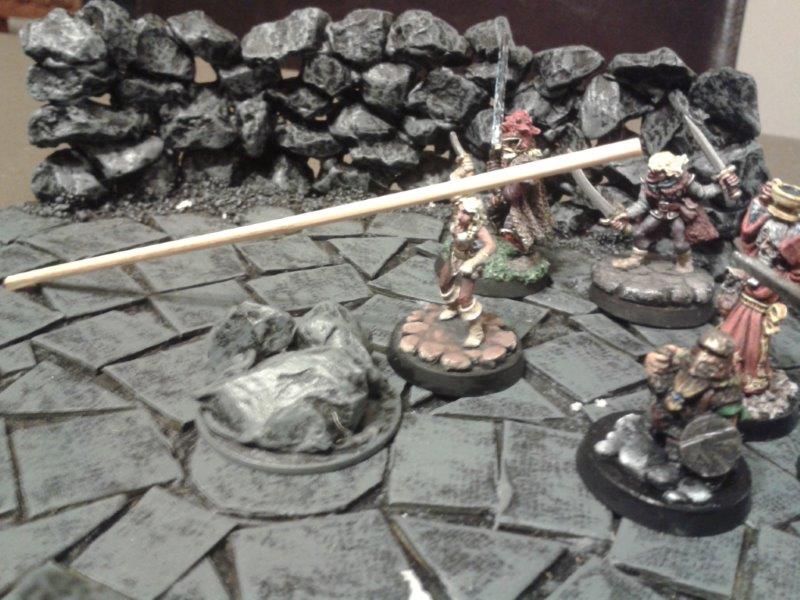This I what I’ve sunk to, folks. I’ve written an article about a ten foot pole, so I’ve clearly fallen to the bottom of the pits. Worse still is I have hope you’ll read it.
Yea, I could’ve written about more mainstream nerd fare or I even could’ve pandered for traffic by creating something linkbaity like The 25 Hottest Video Game Girls of All Time (no link, because). But no, I spent hours researching the history of the ten foot pole of all things, particularly its use in Dungeons and Dragons.
And to think that my 7th grade social studies teacher didn’t think I’d amount to anything.
Dungeons and Dragons: The Ten Foot Pole
Before we consider the 10′ pole of D&D lore, we need to go back in time to discover the history of the ten foot pole itself.
The very first cave men undoubtedly watched David Letterman and discovered that certain things float. Soon thereafter boats were invented, although they were nowhere close to capable of traversing the sea (it was around the turn of the last millennia – the year 1002AD – that Viking Ragnar Lothbrok’s brethren first sailed across the long, cold sea).
Boats were first used in shallow rivers and lakes, while flat bottom boats were used to transport people and goods across bogs and swampy areas, where a wheel just wouldn’t do.
While oars were a consideration, traversing in a flat bottom boat across shallow waters was more effective if they used a long, sturdy wooden pole. Bargemen, standing in the rear of the boat, would thrust the pole into the water where it would eventually find firm footing in the mucky water’s floor, allowing the boatman to push off, guiding and propelling the boat forward.
The poles were also ubiquitous. Boatmen also used the pole used to push away from wharfs, fend off other boats, and a variety of other uses. The simple ten foot pole was surprisingly useful, but hold on to that thought.
The first significant mention of these long, sturdy poles used figuratively was recorded in 1843, in the magazine of the U.S. Masonic community, The Official Magazine of the Grand Lodge of the United States:
But that mushroom aristocracy of our country… who would not condescend to touch a poor man with a ten foot pole, were their extraction traced, in nine cases out of ten they were nurtured in the squalid huts of poverty.
First, why, oh why, do we not still talk like that? Second, a few decades later and the ten foot pole was again being used figuratively in literature. Here is Lady Monkswell’s Diary, 1893:
It will be a long while before any political party touches Home Rule again with the end of a barge pole.
The expression appears to derive from the earlier American phrase ‘I wouldn’t touch that with a ten foot pole’, as barge poles were, in all likelihood, ten foot poles by another name.
At any rate, we’ve come to understand ‘I wouldn’t touch that with a ten foot pole’ to be said of something or someone so unappealing that one wouldn’t want to go anywhere near it, and the phrase is so commonplace that I dare say that we hear it every single day.
Dungeons and Dragons: 101 Ways to Use a Ten Foot Pole
D&D didn’t invent the ‘ten foot pole’, it comes of course from the popular idiom and historical item, but the early editions of D&D were famous for borrowing familiar tropes, much the same way that popular memes are formed on the Internet each day.
A huge part of old school D&D was exploration, mainly in dungeons. The idea of a skill check – rolling a 20-sided die to determine success in disarming a trap – wasn’t invented yet, so imagination and innovation was the primary game mechanic for those types of scenarios. As a result, the ten foot pole was one of the handful of noncombat equipment items listed in D&D gear lists all the way back to OD&D Volume 1: Men & Magic.
Player characters used their mind and whatever gear or equipment they could leverage. Over the years, the ten foot pole has been used in D&D to find pits, bypass deathtraps, climb ledges, prod corpses, poke large beasties to see if they are really dead, [….takes deep breath…] pole-vault over obstacles and chasms, lever loose a statue, measure the depth of water or other scary liquid, strike a giant’s family jewels, carry uncooperative quarry back to camp, and, of course, pole a raft, canoe, or rowboat across a river.
Despite its silliness, the ten foot pole captured players’ imaginations as a universal multi-tool (like the Doctor’s “sonic screwdriver”) to use in exploration. Entire Dragon Magazine articles were dedicated to the merits of the ten foot pole and the trope even spread to other RPG systems.
D&D adventuring parties would have a brave party member probe for traps, using the ten foot pole to locate the the trigger mechanism, then safely disarm or expel it, while the rest of the party was out of the room, presumedly to take a whiz or have a smoke.
Many DMs balked at PCs being able to safely avoid their snares, and I’ve heard tales that some DMs would extend the ‘blast radius’ of their traps past ten feet, which simply incentivized crafty players to start carrying eleven foot poles.
Over the history of D&D this game of cat and mouse between a DM and her players evolved. For example, some DMs would declare that certain magical traps would only trigger when they detected a life form. Hence the necessity for players to use a 10 foot pole with a live chicken tied to the end, which undoubtedly frustrated the DM to no end, even as they gained a respect for the players’ cleverness.
In short, the ten foot pole is simple. A toothpick can serve as the miniature for it. And it has a million creative uses.
Dungeons and Dragons: The Fate of the Ten Foot Pole
This isn’t to say that the 10′ pole didn’t have a couple of glaring weaknesses in RPG play. First, international players are certainly befuddled by it. Only 3 countries – Liberia, Burma, and the United States – claim the Imperial System, using feet for measurement. For the other 192 countries in the world it would be a 3.048 meter pole, which isn’t as endearing.
Second, where can you store this darned unwieldy thing? Don’t even try and tell me a 3 foot halfling or gnome is exploring an enclosed dungeon with a ten foot pole strapped to his rucksack.
There are some options. The easiest being to simply pretend the 10 foot pole is kept in an extra-dimensional plot space. While you are at it, store a seldom referred to NPC in there. The Bag of Holding was invented for such a time as this, so these problems aren’t really problems in a realm of magic.
But, alas, the ten foot pole ultimately fell out of favor. It was just too darned pragmatic to use the wizard’s staff as a credible fill-in for the ten foot pole. But the primary reason was the skill check was invented, so it became standard practice to have your rogue simply roll to disarm or detect a trap.
The current edition – D&D 5e – only passingly refers to the ten foot pole among its equipment list, and young role players are all the poorer for it.
The Ten Foot Pole: Lessons Learned
Lessons learned? Have fun with your game. It is a game after all. The inventors of D&D understood this and even though the ten foot pole is no more, D&D has retained many of these silly little tropes that remind us it’s a fantasy game.
Second, be curious about the lore of objects. Tabletop role playing games are about imagination. If an item doesn’t have a silly use or convoluted backstory, make one up for it.
Finally, it’s a dangerous world out there, my adventuring friends. Be always vigilant against traps and snares, no matter the tool you use to discover them.



